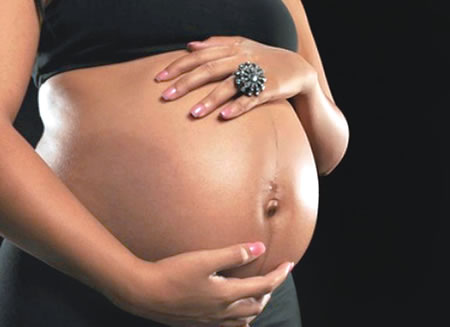MRS Helen Hammed, a 28-year-old mother of one, knew something was wrong when she could not feel her baby’s movement the night before. And, just two days later, her worst fears were confirmed – the baby had no heartbeat.
Helen’s ordeal began when she was 31 weeks pregnant – despite previously having a healthy pregnancy. “It was all perfect and completely normal. The nurses were happy with the growth and at every antenatal visit since they could hear its heartbeat,” she added.
However, Mrs Hammad was heartbroken when the ultrasound scan she was asked to do pronounced that there was no heartbeat.
“The worst part was leaving the hospital without my baby, especially as so many other parents were leaving the same ward with their babies. I started to think ‘why us?’ ‘why me?” recounted Mrs Hammad.
No doubt, feeling the baby’s first kick can be one of the most exciting milestones of pregnancy. Whether it’s the first, second, or third pregnancy, all it takes is that little movement to prove that a brand-new and impressively energetic life is developing in the womb.
Most pregnant women describe their baby’s movements, what is medically termed foetal movement, as butterflies, nervous twitches, or a tumbling motion.
At first, it maybe hard to tell whether the baby has moved. Second- and third-time mothers are more adept at distinguishing those first baby movements from gas, hunger pangs, and other internal motions.
Now, bleeding from the vagina loss of amniotic fluid and a decrease baby movement are a sign that pregnant women are warned to report promptly to the hospital in case they noticed, irrespective of the age of the pregnancy, said Dr Olufemi Adesanya, a consultant gynaecologist.
Dr Adesanya spoke at a training for doctors and midwives on Rotary International’s 2-year programme tagged “Maternal and Perinatal Death Surveillance and Response (MPDSR).”
Adesanya, the Chief Medical Director, Ring Road State Hospital added, “normally, a pregnant woman perceive foetal movement. If there is a reduction or loss of fetal movement, the woman needs to quickly get to the hospital to find out what is happening.
He stated that so many things that can cause a reduction in foetal movement, adding, “ while there isn’t one cause of stillbirth, a decrease in foetal movement can be a warning sign that a baby is in distress.”
There is no set number of normal movements a pregnant woman should be feeling because every baby is different. Howbeit, from 18 to 24 weeks, a woman should feel the baby move more and more. After 32 weeks, the movements will stay roughly the same until she gives birth.
But “for a woman carrying their first baby, we also say if she has not felt her baby move by 18 weeks, it is a cause of worry and requires evaluation to check if there is a problem,” said Dr Olayinka Ogunbode, consultant obstetrics and gynaecologist, University College Hospital (UCH), Ibadan, Oyo State.
Dr Ogunbode said although there is no acceptable number of movements a baby must make, but there is a minimum threshold.
“What is a normal fetal kick for one pregnant woman may not be normal for another. So every woman must be able to establish what is normal for her and get to know how their baby moves. They all have a subjective way of assessing their baby’s movement.
“But whether a baby kicks too little or even too frequently can call for evaluation, we have to check. A baby that moves too frequently, for instance, is at a risk of cord knot or the umbilical cord could become entangled around some part of the body. A cord that knots can kill the baby.”
Dr Ogunbode, however, said the most elementary method pregnant women can use to monitor their baby’s movement is called a foetal kicks chart.
“It must be done at a time when the woman is alert, and then it must cover the period of 12 hours. Any time the woman is feeling the foetal movement, she will be ticking it,” he said
In Nigeria, charting of foetal kicks starts from 28 weeks of pregnancy. It is something mothers can easily do to keep track of their baby’s normal patterns of movement and it requires no special training.
Dr Ogunbode added, “If it is less than 10 movements in 12 hours, then it is a cause of worry. When it is less than 10 movements in 12 hours, there is the possibility of the baby dying in less than 24 hours, which is termed stillbirth.
“This could also be indicative of other problems like placenta detachment, unusual baby position, an overweight mother or a reduced volume of amniotic fluid. Similarly, such babies also stand a higher risk of intrauterine foetal growth restriction, low birth weight or preterm birth.”
The expert, however, declared that alcohol, smoking and drugs such as strong pain relief or sedatives can get into the baby’s circulation may also affect the baby’s movements.
Reduced movements can be the result of the mother supplying too much blood sugar to the baby, as in mothers with diabetes or prediabetic states. This is because oxygen is used to metabolise glucose, leaving little for foetal activity.
It is known that fewer movements are perceived when women are standing or sitting, compared with lying down or concentrating on movements.
Also, the quality of those movements changes beyond week 30 of pregnancy. No longer will the baby be able to flip around as readily as the womb becomes increasingly cramped.
Soon enough, rather than feeling acrobatic-like twists and turns, instead what is experienced may be little tickles and squirming motions. There may also be a sudden jab or kick that can feel downright uncomfortable.
Generally speaking, it is natural to go from feeling big movements during early pregnancy to experiencing smaller squirms and jabs in later pregnancy. It is also common to feel less motion as the baby begins to takes a vertex (head down) position in the womb.
Babies tend to move more at certain times of day as they alternate between alertness and sleep. Usually, the afternoon and evening periods are their peak activity time.
Paradoxically, a study warned that pregnant women who notice their baby is less active than usual in the evenings should not leave it to the morning before they get evaluated at the hospital.
In most cases, this will provide reassurance that the baby is doing okay, although some women may need a follow-up scan or closer monitoring.
The advice comes after a finding from a New Zealand study that women who reported their babies were ‘quiet’ in the evening, with light or no movement, had an almost four times’ greater risk of stillbirth compared to women with nocturnally active babies.
In this study, researchers interviewed 164 women who had recently experienced a late stillbirth and asked them what their baby’s movements had been like in the two weeks before the baby died. Around half of those women had lost their baby at 37 weeks or later.
The findings, published in the journal Scientific Reports, confirmed that decreased frequency and decreased strength of baby movements were linked to stillbirth. Most strikingly, for babies who had quiet or light movement in the evening, stillbirth risk increased by nearly fourfold (3.82 times).
Moreover, in 2009, researchers in Norway found when pregnant women were trained to count and track fetal movements in the third trimester, the stillbirth rate decreased by nearly 50 per cent. They presented these findings at a conference in Washington, D.C.






